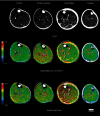Possibility for Visualizing the Muscle Microstructure by q-Space Imaging Technique
- PMID: 35979242
- PMCID: PMC9377983
- DOI: 10.1155/2022/7929589
Possibility for Visualizing the Muscle Microstructure by q-Space Imaging Technique
Abstract
In the human body, skeletal muscle microstructures have been evaluated only by biopsy. Noninvasive examination of the microstructure of muscles would be useful for research and clinical practice in sports and musculoskeletal areas. The study is aimed at determining if q-space imaging (QSI) can reveal the microstructure of muscles in humans. Forty-three Japanese subjects (controls, distance runners, powerlifting athletes, and teenage runners) were included in this cross-sectional study. Magnetic resonance imaging of the lower leg was performed. On each leg muscle, full width at half maximum (FWHM) which indicated the muscle cell diameters and pennation angle (PA) were measured and compared. FWHM showed significant positive correlations with PA, which is related to muscle strength. In addition, FWHM was higher for powerlifting, control, distance running, and teenager, in that order, suggesting that it may be directing the diameter of each muscle cell. Type 1 and type 2 fibers are enlarged by growth, so the fact that the FWHM of the control group was larger than that of the teenagers in this study may indicate that the muscle fibers were enlarged by growth. Also, FWHM has the possibility to increase with increased muscle fibers caused by training. We showed that QSI had the possibility to depict noninvasively the microstructure like muscle fiber type and subtle changes caused by growth and sports characteristics, which previously could only be assessed by biopsy.
Copyright © 2022 Yasushi Sera et al.
Conflict of interest statement
Daisuke Nakashima is the president of Grace Imaging Inc. and holds shares in this company. Yasushi Sera, Daisuke Nakashima, Junichi Hata, and Masaya Nakamura hold the patent on this research. The other authors declare that they have no known competing financial interests or personal relationships that could have appeared to influence the work reported in this paper.
Figures





Similar articles
-
Noninvasive technique to evaluate the muscle fiber characteristics using q-space imaging.PLoS One. 2019 Apr 4;14(4):e0214805. doi: 10.1371/journal.pone.0214805. eCollection 2019. PLoS One. 2019. PMID: 30947237 Free PMC article.
-
Neuromuscular differences between volleyball players, middle distance runners and untrained controls.Int J Sports Med. 1995 Aug;16(6):390-8. doi: 10.1055/s-2007-973026. Int J Sports Med. 1995. PMID: 7591391
-
Quantitative analysis of intervertebral disc degeneration using Q-space imaging in a rat model.J Orthop Res. 2020 Oct;38(10):2220-2229. doi: 10.1002/jor.24757. Epub 2020 Jun 5. J Orthop Res. 2020. PMID: 32458477
-
Contributions to the understanding of gait control.Dan Med J. 2014 Apr;61(4):B4823. Dan Med J. 2014. PMID: 24814597 Review.
-
Effect of Strength Training on Biomechanical and Neuromuscular Variables in Distance Runners: A Systematic Review and Meta-Analysis.Sports Med. 2020 Jan;50(1):133-150. doi: 10.1007/s40279-019-01184-9. Sports Med. 2020. PMID: 31541409
References
LinkOut - more resources
Full Text Sources

